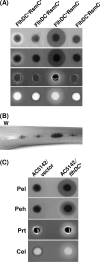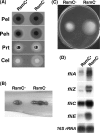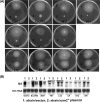RsmC of Erwinia carotovora subsp. carotovora negatively controls motility, extracellular protein production, and virulence by binding FlhD and modulating transcriptional activity of the master regulator, FlhDC
- PMID: 19447906
- PMCID: PMC2704716
- DOI: 10.1128/JB.00154-09
RsmC of Erwinia carotovora subsp. carotovora negatively controls motility, extracellular protein production, and virulence by binding FlhD and modulating transcriptional activity of the master regulator, FlhDC
Erratum in
-
Correction for Chatterjee et al., RsmC of Erwinia carotovora subsp. carotovora Negatively Controls Motility, Extracellular Protein Production, and Virulence by Binding FlhD and Modulating Transcriptional Activity of the Master Regulator, FlhDC.J Bacteriol. 2015 Dec;197(24):3848. doi: 10.1128/JB.00735-15. J Bacteriol. 2015. PMID: 26581822 Free PMC article. No abstract available.
Abstract
RsmC and FlhDC are global regulators controlling extracellular proteins/enzymes, rsmB RNA, motility, and virulence of Erwinia carotovora subsp. carotovora. FlhDC, the master regulator of flagellar genes, controls these traits by positively regulating gacA, fliA, and rsmC and negatively regulating hexA. RsmC, on the other hand, is a negative regulator of extracellular proteins/enzymes, motility, and virulence since the deficiency of RsmC in FlhDC(+) strain results in overproduction of extracellular proteins/enzymes, hypermotility, and hypervirulence. These phenotypes are abolished in an RsmC(-) FlhDC(-) double mutant. We show that RsmC interferes with FlhDC action. Indeed, the expression of all three targets (i.e., gacA, rsmC, and fliA) positively regulated in E. carotovora subsp. carotovora by FlhDC is inhibited by RsmC. RsmC also partly relieves the inhibition of hexA expression by FlhDC. The results of yeast two-hybrid analysis revealed that RsmC binds FlhD and FlhDC, but not FlhC. We propose that binding of RsmC with FlhD/FlhDC interferes with its regulatory functions and that RsmC acts as an anti-FlhD(4)FlhC(2) factor. We document here for the first time that RsmC interferes with activation of fliA and motility in several members of the Enterobacteriaceae family. The extent of E. carotovora subsp. carotovora RsmC-mediated inhibition of FlhDC-dependent expression of fliA and motility varies depending upon enterobacterial species. The data presented here support the idea that differences in structural features in enterobacterial FlhD are responsible for differential susceptibility to E. carotovora subsp. carotovora RsmC action.
Figures






Similar articles
-
Regulatory network controlling extracellular proteins in Erwinia carotovora subsp. carotovora: FlhDC, the master regulator of flagellar genes, activates rsmB regulatory RNA production by affecting gacA and hexA (lrhA) expression.J Bacteriol. 2008 Jul;190(13):4610-23. doi: 10.1128/JB.01828-07. Epub 2008 Apr 25. J Bacteriol. 2008. PMID: 18441056 Free PMC article.
-
rsmC of the soft-rotting bacterium Erwinia carotovora subsp. carotovora negatively controls extracellular enzyme and harpin(Ecc) production and virulence by modulating levels of regulatory RNA (rsmB) and RNA-binding protein (RsmA).J Bacteriol. 1999 Oct;181(19):6042-52. doi: 10.1128/JB.181.19.6042-6052.1999. J Bacteriol. 1999. PMID: 10498717 Free PMC article.
-
Regulation of motility in Erwinia carotovora subsp. carotovora: quorum-sensing signal controls FlhDC, the global regulator of flagellar and exoprotein genes, by modulating the production of RsmA, an RNA-binding protein.Mol Plant Microbe Interact. 2010 Oct;23(10):1316-23. doi: 10.1094/MPMI-01-10-0017. Mol Plant Microbe Interact. 2010. PMID: 20831410
-
Effects of the two-component system comprising GacA and GacS of Erwinia carotovora subsp. carotovora on the production of global regulatory rsmB RNA, extracellular enzymes, and harpinEcc.Mol Plant Microbe Interact. 2001 Apr;14(4):516-26. doi: 10.1094/MPMI.2001.14.4.516. Mol Plant Microbe Interact. 2001. PMID: 11310739
-
Global regulation by the small RNA-binding protein CsrA and the non-coding RNA molecule CsrB.Mol Microbiol. 1998 Sep;29(6):1321-30. doi: 10.1046/j.1365-2958.1998.01021.x. Mol Microbiol. 1998. PMID: 9781871 Review.
Cited by
-
Master regulator genes and their impact on major diseases.PeerJ. 2020 Oct 6;8:e9952. doi: 10.7717/peerj.9952. eCollection 2020. PeerJ. 2020. PMID: 33083114 Free PMC article.
-
Flagellar region 3b supports strong expression of integrated DNA and the highest chromosomal integration efficiency of the Escherichia coli flagellar regions.Microb Biotechnol. 2015 Jul;8(4):726-38. doi: 10.1111/1751-7915.12296. Microb Biotechnol. 2015. PMID: 26074421 Free PMC article.
-
Anti-phytopathogenic activities of macro-algae extracts.Mar Drugs. 2011;9(5):739-756. doi: 10.3390/md9050739. Epub 2011 May 3. Mar Drugs. 2011. PMID: 21673886 Free PMC article.
-
CRISPR-Cas gene-editing reveals RsmA and RsmC act through FlhDC to repress the SdhE flavinylation factor and control motility and prodigiosin production in Serratia.Microbiology (Reading). 2016 Jun;162(6):1047-1058. doi: 10.1099/mic.0.000283. Epub 2016 Mar 24. Microbiology (Reading). 2016. PMID: 27010574 Free PMC article.
-
Identification by Tn-seq of Dickeya dadantii genes required for survival in chicory plants.Mol Plant Pathol. 2019 Feb;20(2):287-306. doi: 10.1111/mpp.12754. Epub 2018 Nov 15. Mol Plant Pathol. 2019. PMID: 30267562 Free PMC article.
References
-
- Aizawa, S. I., and T. Kubori. 1998. Bacterial flagellation and cell division. Genes Cells. 3625-634. - PubMed
-
- Aldridge, P., and K. T. Hughes. 2002. Regulation of flagellar assembly. Curr. Opin. Microbiol. 5160-165. - PubMed
-
- Barembruch, C., and R. Hengge. 2007. Cellular levels and activity of the flagellar sigma factor FliA of Escherichia coli are controlled by FlgM-modulated proteolysis. Mol. Microbiol. 6576-89. - PubMed
-
- Barras, F., F. Van Gijsegem, and A. K. Chatterjee. 1994. Extracellular enzymes and pathogenesis of soft-rot Erwinia. Annu. Rev. Phytopathol. 32201-234.
Publication types
MeSH terms
Substances
LinkOut - more resources
Full Text Sources
Molecular Biology Databases

